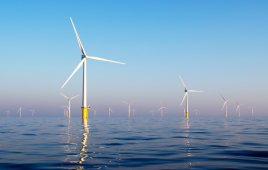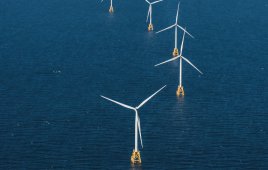Editor’s note: Researchers at the National Renewable Energy Laboratory (NREL) teamed up with the wind industry at the National Wind Technology Center (NWTC) to study the flight patterns of two eagles. Data collected will lead to the development of systems to better detect birds and prevent collisions with turbines. Here is information from NREL Project Manager, Kelly Yaker, as posted on the Department of Energy’s website.

NREL researcher Jason Roadman and veterinarian Seth Oster release a bald eagle from a lift during one of the test flights. (Photo: Lee Jay Fingersh)
A bald eagle named Spirit and a golden eagle named Nova are helping researchers make wind energy safer for birds. NREL, one of the Department of Energy’s 17 National Laboratories, partnered with industry to gather data about bird flight patterns, which will help the companies develop technology to reduce bird collisions with turbines.
The team conducted 25 flights and collected terabytes of data for the project, which borrowed the two eagles from Auburn University.
It all took place at the NWTC, a giant test center NREL operates just outside of Boulder, Colorado. The work is a partnership between Laufer Wind and NREL, a notable example of a national lab partnering with the wind industry to help improve technology. Partnerships such as this help new technologies get to the market faster.
Two companies — Laufer Wind and RES Americas — have avian detection systems installed at the test center. Laufer invited RES to participate so both companies could benefit from shared information. To gather the data, the birds carried a GPS logger, and their flights were conducted at various angles to the two detection systems. By comparing the GPS data collected with the results from the two avian detection systems, developers will be able to better characterize the behavior of their detection algorithms and improve their analysis methods.
Laufer Wind will be using the data collected to test and validate wind turbine radar used to detect birds (they already detect aircraft). RES’ product IdentiFlight, created in collaboration with Boulder Imaging, is a stereoscopic camera-based system to detect and identify flying wildlife. Both systems are designed to reduce the chances of eagle and other avian collisions with wind turbines and will benefit greatly from data gathered from flights of these specific eagle species.
While this is not the first time the NWTC has hosted birds to track their flight patterns, project lead Jason Roadman explained that this is the first large-scale field research campaign to collect flight data.
The project evolved from the first flights last year. The team learned quite a bit from the first flights and used it to improve the 2016 project. Roadman says they continue to learn a lot about the specific birds being used to gather data and what type of flight patterns they can record.
The birds used in the recent flights belong to Auburn University’s Southeastern Raptor Center, a rehabilitation center for birds of prey. These eagles are not trained for extensive flights; they are trained to soar across a football stadium and land on the field, so the researchers modified their tests accordingly. They used a man lift to take the eagles as high as possible before releasing them so they could trade altitude for airspeed.
Roadman attributes much of this project’s inspiration to his sister, Adrian Roadman, a wildlife biologist.
“I’m not a wildlife guy,” he explains. “My training is all in engineering.” But Roadman bounced a lot of his ideas for this type of testing off his sister and credits the concept to her knowledge in the wildlife biology field.
Roadman hopes to continue this project into the future by running similar tests with a variety of birds in order to collect even more data for the detection systems to use when refining their systems to track bird flight patterns.
Check out the video by the Energy Department’s, Simon Edelman. (Footage courtesy of the National Renewable Energy Laboratory and RES America.)
Filed Under: News, Safety




